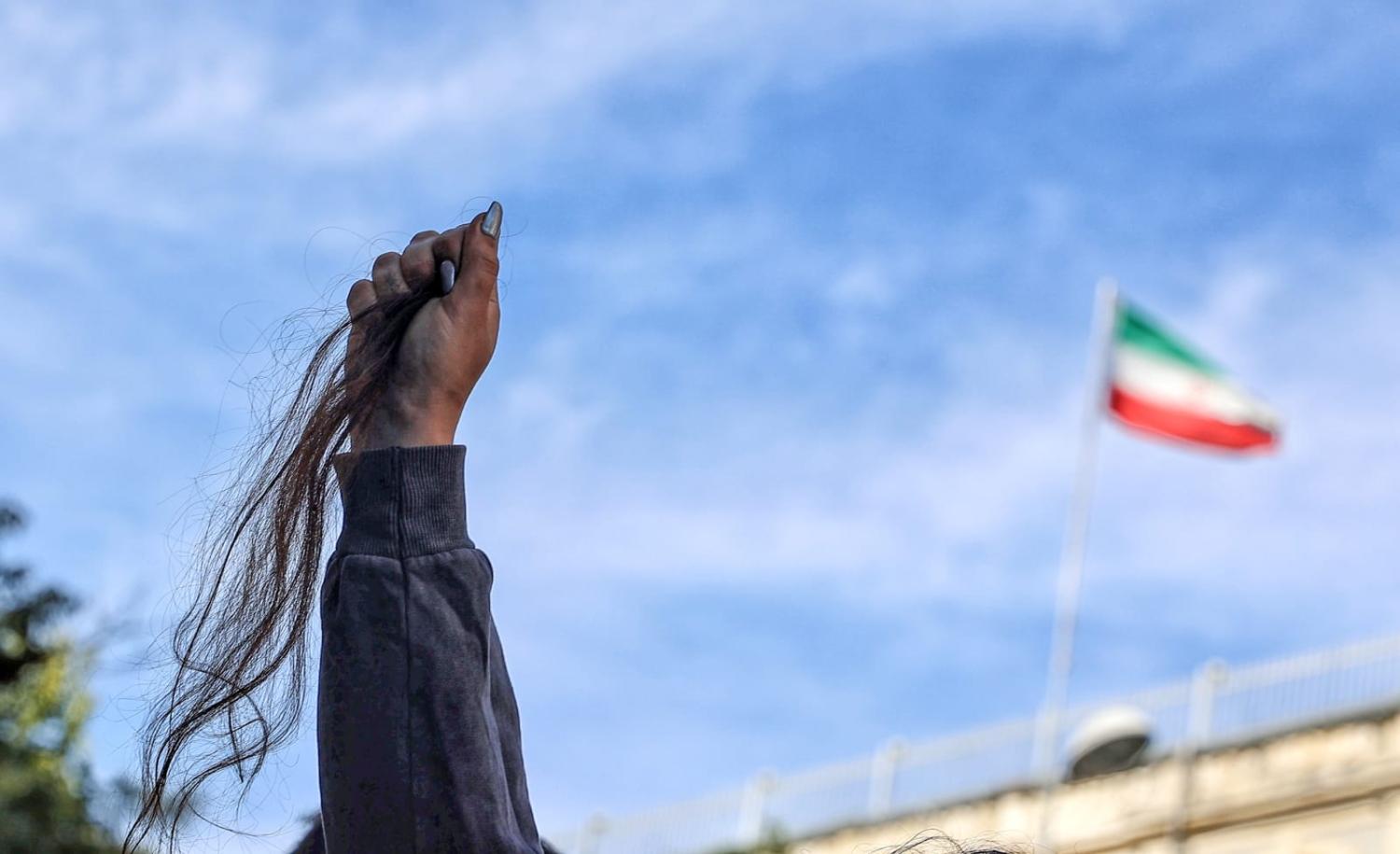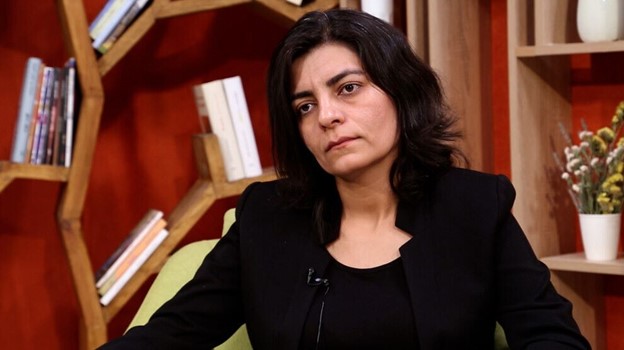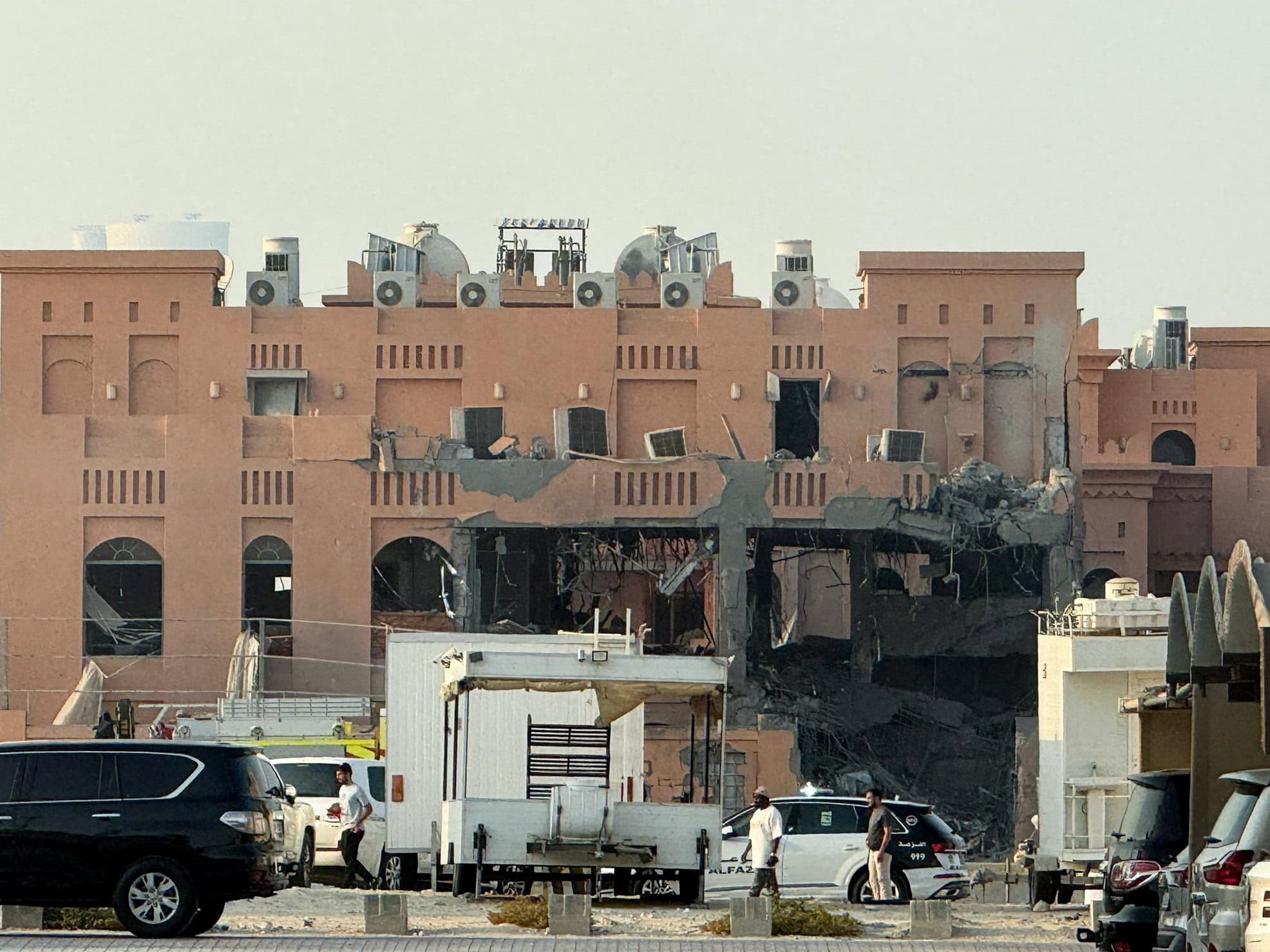
Cutting hair has become the icon of the international protests to support Iranian demonstrators in response to the killing of the 22-year-old Mahsa Amini (Ozan Guzelce via Getty Images).
آخر تحديث في: 25-10-2022 الساعة 4 مساءً بتوقيت عدن
Farida Ahmed (South24)
“Women, life, freedom”, “The Morality Police are killers”, “Unity from Kurdistan to Tehran”. With these slogans and banners, the popular revolution broke out in Iran as well as a number of European states and the US. The protests completed its 4th week in a row since they sparked on September 14th after the death of Iranian young woman “Mahsa Amini” who had Kurdish origin. She was brutally beaten while detained by the Morality Police affiliated with the Iranian government because she was wearing the so-called “bad hijab” [1]. What happened to Mahsa was not a surprise as many Iranian women are subjected to repression because of the mandatory hijab laws. According to Article (638) of the “Islamic Penalties”, the punishment of taking off the hijab varies between reprimanding, a financial fine of about 20$ and the imprisonment from 10 days to 2 months. [2]
So far, and according to human rights organizations, over 133 persons were killed during the latest Iranian protests while 1200 at least were detained including civil society members who were not arrested in the street during demonstrations but being arbitrarily dragged from their homes or their workplaces. [3] However, the regime has not been yet able to calm down the popular anger which increases day after day in different areas of the country. According to estimates, the latest protests have been beyond all nationalities, classes, generations and divisions. This is a point of strength that allowed them to continue if compared with previous protests which were quickly suppressed. This includes the so-called “the Green Revolution” in 2009 against the regime which witnessed many casualties.
Certainly, this has put much pressure on the Iranian regime, foremost of which is the economic pressure that gradually escalates. On the other hand, the successive regimes failed to deal properly with the Western sanctions in regard to basic issues such as the nuclear program, ballistic missiles and the regional interventions. Furthermore, the consecutive European and American stances condemning the Tehran behaviors were described by the spokesman of Iran’s Ministry of Foreign Affairs Nasser Kanaani as being blatant interference by some Western states to support riots in Iran. He said: “the enemies don’t only oppose the Islamic Republic but they antagonize Iran”. [4]
Change in the women’s leadership
Since the death of “Mahsa”, the recent protests have been characterized by intensified female participation, especially the teenagers who cut their hair and took off their hijab to denounce the actual conditions of women in Iran. This comes amid attempts by Iranian politicians and clergymen to create an obligatory religious identity of the female dress code in a way that matches the identity of the Islamic Republic.
In an exclusive interview with “South24 Center”, Iranian Kurdish activist [5] Rosarin Kamanager, the Diplomatic Officer of the “Free Women’s System in Rojhilat Kurdistan” said that “the current protests have historical, social, political, and cultural background. Women participated in all demonstrations and struggles in different circumstances. Moreover, the patriarchal government and the Iranian people provided a special definition of women’s presence in a way that puts itself in the center while leaving women on the margin”.
 Iranian Kurdish activist Rosarin Kamanager, the Diplomatic Officer of the “Free Women’s System in Rojhilat Kurdistan
Iranian Kurdish activist Rosarin Kamanager, the Diplomatic Officer of the “Free Women’s System in Rojhilat Kurdistan
She added: “Women suffer from restrictions based upon rules and Islamic Sharia in Iran. Prisons are full of female prisoners who are not properly known including “Zeynab Jalalian” and others. Moreover, women are imprisoned in their houses and repressed in the name of honor and law. It is remarkable hat women don’t accept such slavery definitions as they have expressed their reluctance to be the victims of the governmental policies over the past period”.
It has been clear that since Ibrahim Raisi ascended to power in 2021, there has been an intensified presence of the so-called “Guidance Patrols” or “Morality Police” and stricter laws have been imposed related to the dress code. Telecom companies sent summoning messages to some women to be investigated for reasons related to their hijab. The scenes of dragging women to the “Guidance Patrols” vehicles became common in Iran. This has deepened their insistence to continue protesting and reject the laws that suppress them.
Kamanager believes that the most distinctive feature of this uprising is the clear presence of female elements across the Iranian cities. Furthermore, the slogan “Women, life and freedom” demonstrated the close relationship between these three. She added that the Iranian people sent a unity and consolidation message to women from Balochistan to Kurdistan, Azerbaijan, Ahvas and northern Iran to support all females. This slogan is shared by all ethnic, national and religious sects although the so-called “Divide and Rule” policy which has separated nations from each other.
Undoubtedly, the religious regime and its security bodies are obsessed by feelings that the Western forces seek to destroy the Islamic identity and culture and therefore, they negatively exaggerate the hijab issue and the way of dealing with women and that caused this form of rebellion. Kamanager added that “what Iran has experienced can be called a revolution as it has been ongoing for more than one month and it has spread from one city to another and from one village to another. What happens is a form of a mental revolution by the Iranian people. However, the main issue is that we want a drastic change in the mentality of governance, basic laws, and executive policies of the regime. This means that the regime is not able to continue ruling by using this way of policy. It does not seem that the latest protests are limited to reforms or changing some laws related to hijab. They called on the regime to step down using some slogans such as “Death to the dictator” which is a reference to the Supreme Leader “Ali Khamenei”. This scene seems different from previous demonstrations. Kamanager added: “The Iranian people have numerous experiences across history related to the ways of ruling. Former protesters previously demonstrated because they didn’t accept the Pahlavi regime’s way of ruling. The same slogans are currently repeated again in the same direction as they don’t want a dictator. We saw how peoples in the Middle East made their revolutions based upon their latent power. Therefore, the continuity of the internal protests and the supportive messages from outside will help this uprising to bear fruits towards change.
Political regime and the successor
It is clear that along with the crisis of ongoing protests for the Iranian regime, there is the legitimacy crisis which has long caused ongoing confusion among the Iranian leaders, whether at the level of the Supreme Leader or the President. This was clear in the first dispute between the two parties in April 2011 during the era of the then President Mahmoud Ahmadinejad who abolished a decision taken by Khamenei regarding the security establishment. This caused a very sensitive crisis among them [6]. Speculations pointed to the possibility of abolishing the president position and to keep the authority into the hands of the Supreme Leader only. Iran has a previous experience in removing the Prime Minister post by the constitutional amendments in 1989. According to Chapter 2, Article 133, “the President appoints the ministers and asks the Islamic Consultative Assembly to make a vote of confidence. Asking for confidence again is not required if the Islamic Consultative Assembly changes. [7] The last Prime Minister of Iran was Mir-Hossein Mousavi in 1989.
Despite all speculations regarding the Presidential establishment, "Nejad" remained the president before being succeeded by Hassan Rouhani who was followed by Ibrahim Raisi who still holds the office. However, concerns remain regarding any sudden changes, especially amid the current crisis and the anti-regime moves. On the other hand, there have been other speculations of restoring the position of prime minister and shifting the regime from a presidential to a parliamentary one while the highest authority in the state will remain in the hands of the Supreme Leader. However, the biggest dilemma that could face the religious authority in Iran is that its leader "Khamenei”, who has been the longest in power since the establishment of the Islamic Republic, suffers from deteriorating health conditions amid very strong blackout attempts by the regime. The most likely is that his expected death in any moment will cause big changes at the internal level which has already witnessed strong religious competition regarding who will succeed the Supreme Leader as well as the expected political changes. This is along with the transformations whose impact will extend to the region and neighbors in general regarding a number of files, foremost of which probably is the Yemeni file in which the Tehran-backed Houthis pose an upsetting threat to the region.
The Iranian Revolutionary Guards may have an informal impact in selecting the successor but the Assembly of Experts is the one which nominates and elects the successor according to the Iranian Constitution. It is in charge of supervising the general policy in Iran and the declaration of war or peace as well as the public alarm. It also serves as the Commander in Chief of the Armed Forces. The Assembly of Experts has the right to depose the Supreme Leader if he becomes unable to do his duties or loses one of his credentials stipulated in Article (110) of Chapter Eight and to appoint another one in case of his death. [8] Away from all of this, and despite the impact of the Revolutionary Guards and the Assembly of Experts, the deep state in Iran has a complicated and tangled network of figures and interests which basically aims to maintain the revolutionary nature of the Islamic Republic and impose its security and religious base by using different means. Such a vision was and still serves as the most comfortable area to hold its grip over the country for more than 4 decades.
The impact on the internal and the regional levels
Many foreign states, organizations, activists across the world have expressed their support to the protests in Iran including the intensified media coverage of them. For example, Washington announced that it reduced the technology restrictions imposed against Iran in order to expand the accession to internet services which are restricted by the government as part of its campaign to suppress demonstrations. [9] Such support has largely contributed to the spread and the continuity of the protests. These pressures could largely affect the Iranian regime policy through two directions, the first of which is the regime's preoccupation with the internal issues regarding the latest accelerated developments. This would distract the Iranian decision makers away from following-up foreign affairs. The second is that the economic pressures may lead to growing internal economic pressure. This would relatively reduce funding the foreign arms affiliated with Iran which would lead Iran to make a bargain to restore the cohesiveness of its internal interests at the expense of its interests abroad. This will depend on the outcome of the demonstrations and the level they could reach during the coming period.
It is important to say that what happens in Iran will largely impact the entire region in spite of the efforts by some Gulf States to reshape their diplomatic map with Tehran such as the UAE and Kuwait. However, the KSA adopts a more cautious approach and probably more interactive towards the recent popular protests. The Saudi stance has been clear through the intensified coverage by its official media platforms of what happens there or by backing Farsi -speaking channels such as “Iran International”. In response to that, Tehran warned Riyadh by Iranian Revolutionary Guards Commander Major General Hossein Salami who asked the KSA not to interfere in his country’s internal affairs. [10]
To continue pressure on Iran and besiege its dangerous policies in the region, the Western and regional states will have to support these protests and encourage the escalatory popular rejection against the ruling regime. This will likely help to make positive transformations for the Iranians at the economic level and women rights. In the long run, this could contribute to correcting Iran’s policies and its relationships with the region.
As for Yemen, the failure to extend the truce between the Houthis and the internationally-recognized government on October 2nd may be a possible result of the developments in Iran. The latter likely wants to maintain its threats against the Gulf security and the region at a time it faces an extended popular challenge. Therefore, signing a 5-month expanded truce will be too long and will be a big obstacle for Iran to respond to the KSA’s stances by using its proxies. The Houthis already threatened to target the local oil companies and those which operate in Saudi Arabia and the UAE in the last day of the truce. [11]
Currently, the Iranian uprising can encourage the Yemenis in the areas controlled by the Houthis to move. This is not an unlikely possibility in light of Iran’s loss of control over its internal situation and its being distracted away from its proxies. However, the most prominent dilemma that could face Northern people is their lack of order and the scale of the arbitrary restrictions imposed by the Houthis. Additionally, people in North Yemen don’t trust the internationally-recognized government and the Arab Coalition to provide any logistic support to begin such a move. In the past, North Yemen has witnessed military endeavors to revolt against the Houthis but the latter managed to suppress them. This includes for example the Battle of Utmah in Dhamar governorate which sought to restore the governorate from the Houthis in 2015, the Hajour Battle in Hajjah governorate between the tribes and the Houthis in early 2019 and the uprising by Al-Bayda tribes in 2020.
In general, the outcome of the developments in Iran has not been clear yet. Nonetheless, It is important to construct a more comprehensive picture about the status quo and to be ready for any tension or escalation that would push Tehran to adopt a more hostile and militarized approach to defend its national interests in the face of the outside world. This may cause a crisis and create new challenges in the region which have not been taken into account.
Executive Director of South24 Center for News and Studies, researcher and journalist in political affairs.
1- The “bad hijab” in Iran means wearing it inappropriately by showing a little bit of the front hair. This is the opposite of what is called the “supreme hijab”, which completely conceals the hair.
2- ”Hijab in Iran: Between Ideology and Politics”, International Institute for Iranian Studies (rasanah-iiis.org)
3- Supportive protests abroad... The death toll in Iran rises to 133. (alarabiya.net)
4- Protests in Iran... Accusations against the West of targeting the education sector and threats to take measures against any European sanctions. (mdeast.news)
5- An interview conducted by the author with Iranian Kurdish activist Rosarin Kamanager on October 18th 2022.
6- A Dispute between Ahmadinejad and Khamenei/News, Reports and Interviews/Al-Jazeera Net. (azureedge.net)
7- ”From the Shah to Nejad: Iran from Where to Where? Mohammed Sadiq Ismail, P 132.
8- The Iranian Constitution, )
9- Iran protests expand... Washington facilitates Internet accession. (alarabiya.net)
10- Commander of the Iranian Revolutionary Guards again warns Saudi Arabia: Protect yourself inside the glass palaces. (CNN Arabic)
11- Un extended truce... The Houthis threaten to target oil companies in Saudi Arabia and the UAE. (CNN Arabic)

قبل 3 أشهر

قبل 3 أشهر